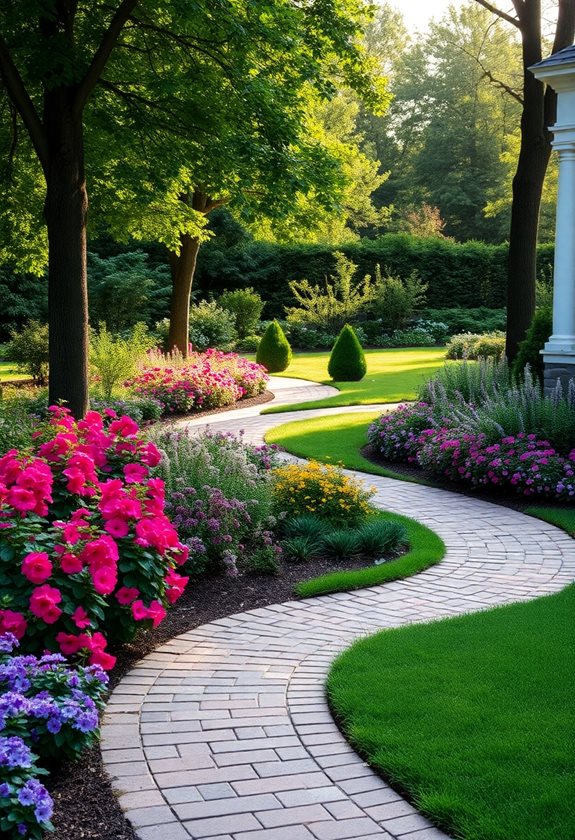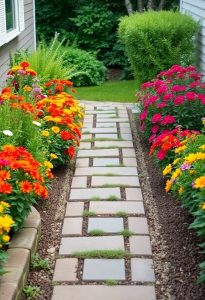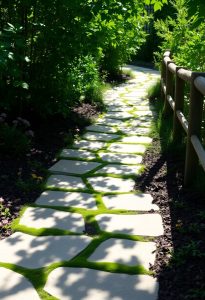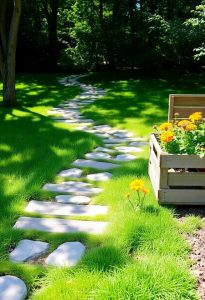Creating elegant brick pathways in your flower garden is like carving a treasure map to beauty! Start by choosing the right brick style and color that complements your blooms. Plan a winding layout that invites exploration, keeping paths about 3 feet wide for comfort. Don’t forget to add edging for stability and think about drainage—water pooling isn’t fun! With the right base material, your pathway will shine. Ready to discover more tips and tricks for your garden?
Design Highlights
- Choose warm earth tones or cool grays for bricks to harmonize with garden aesthetics and enhance visual appeal.
- Plan a pathway layout with curves to create an inviting and exploratory feel through the garden.
- Ensure a pathway width of about 3 feet for comfortable walking, avoiding cramped or excessively wide designs.
- Incorporate edging with matching bricks or wood for stability and to enhance the overall charm of the pathway.
- Ensure proper drainage by sloping paths away from flower beds and using gravel or sand in the sub-base.
Choose the Right Brick Style and Color
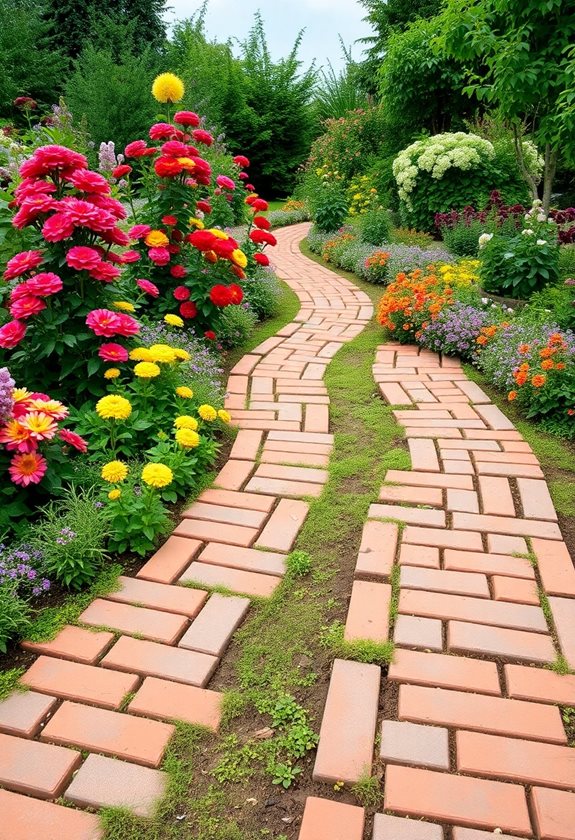
When you’re planning to create elegant brick pathways in your flower garden, it’s essential to choose the right brick style and color, especially since the wrong choice can clash with your blooming beauties. Think about the overall vibe you want—do you prefer rustic charm or modern sleekness? Consider these tips:
Choosing the right brick style and color for your garden pathway is crucial for creating a harmonious and inviting space.
- Warm Earth Tones: They harmonize beautifully with vibrant flowers.
- Cool Grays: Perfect for a modern touch.
- Textured Bricks: They add depth and interest.
Picture your pathway: does it invite you to stroll through your garden? Choose wisely, and your pathway will be a stunning focal point! Additionally, elegant brick pathways can enhance the overall aesthetics of your garden while providing a durable surface for walking.
Plan Your Pathway Layout
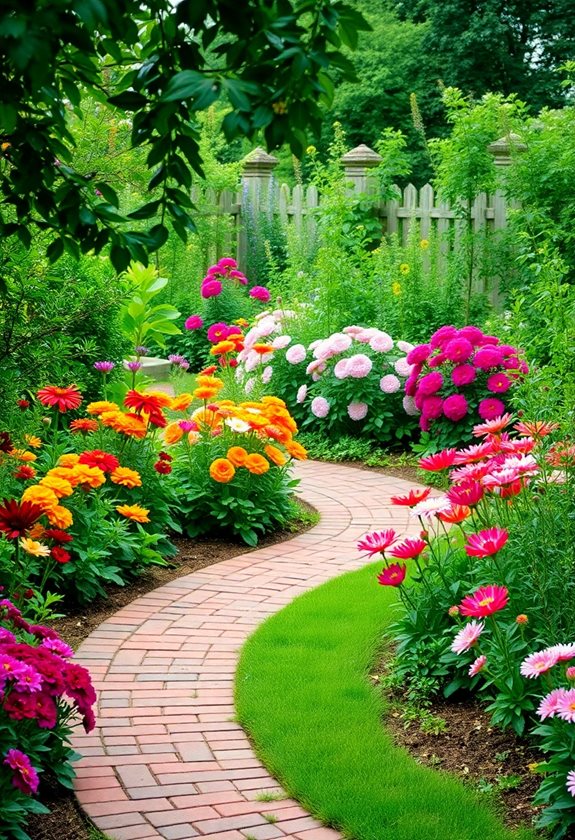
Creating a beautiful pathway in your flower garden isn’t just about the bricks you choose; it’s also about how you lay them out! Start by sketching your ideas—think about where you want the path to lead. Will it wind through lush blooms or connect key areas like a seating spot? Visualize the flow! Consider using curves for a natural feel; straight lines can be more formal. You might even want to lay your bricks temporarily to see how they fit the space before committing. Remember, the perfect layout invites exploration and joy—so have fun with it! Let your creativity shine! Additionally, choosing the right materials ensures pathways can withstand weather conditions while enhancing the overall aesthetic of your garden.
Consider Pathway Width and Shape
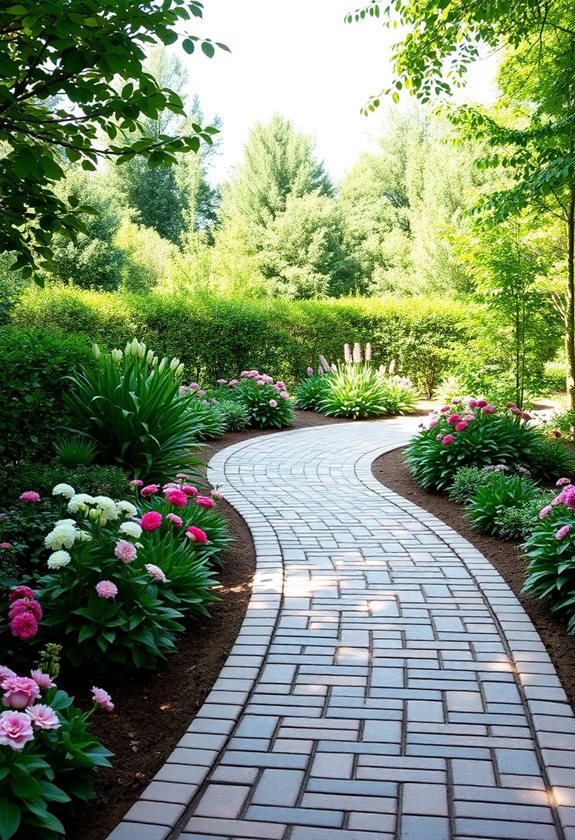
While it might seem tempting to just plunge into laying bricks, thinking about your pathway’s width and shape can really make a difference in how your garden feels. Have you ever walked down a path that felt cramped or too wide? Aim for about 3 feet wide for comfortable strolls, allowing for two people to chat without bumping elbows! As for shape, consider curves over straight lines; they add softness and elegance. Use gentle bends to guide visitors through your flower haven, inviting exploration. Remember, a well-thought-out pathway not only enhances beauty but also encourages delightful garden adventures! Additionally, incorporating pathway lighting ideas can elevate the charm of your brick pathways even after sunset.
Incorporate Edging for Stability
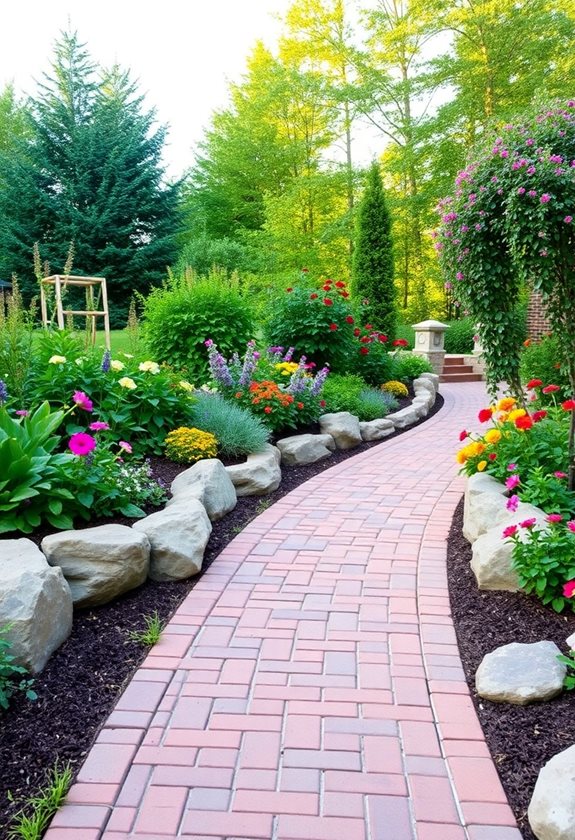
How can you make certain your beautiful brick pathways stay intact and look fabulous for years to come? Incorporating edging is key! Edging not only enhances the aesthetic appeal but also provides much-needed stability. Consider these options:
- Brick or Stone: Match your pathway materials for a seamless look.
- Metal Edging: Offers a sleek, modern vibe while keeping bricks in place.
- Wood: A rustic charm that complements your garden’s natural beauty.
Trust me, I once skipped this step and watched my pathway slowly crumble! So, don’t overlook edging; it’s your pathway’s best friend for lasting elegance! Additionally, using weather-resistant materials can significantly prolong the life of your pathway edging.
Ensure Proper Drainage
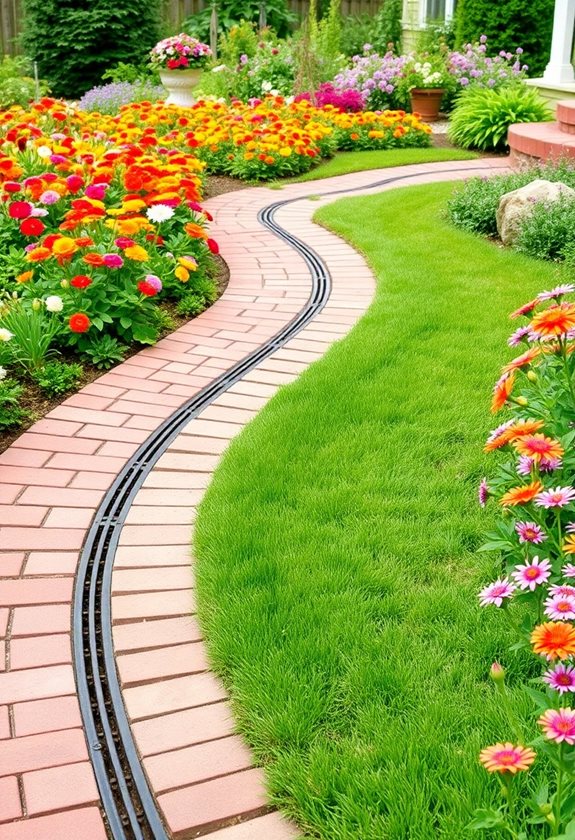
When you’re laying those stunning brick pathways, you might not think about drainage right away, but trust me, it’s vital! Without proper drainage, water can pool, leading to unsightly mud and even damaging your beautiful bricks. So, how can you guarantee good drainage? Start by sloping your path slightly away from your flower beds. Use gravel or sand in the sub-base to promote water flow. Think about adding drainage channels or even planting water-loving plants nearby to soak up excess moisture. Additionally, keeping your pathways clean will help prevent algae growth that can thrive in damp conditions. Remember, a well-drained path not only looks great but keeps your garden thriving. Who wouldn’t want that?
Select the Right Base Material
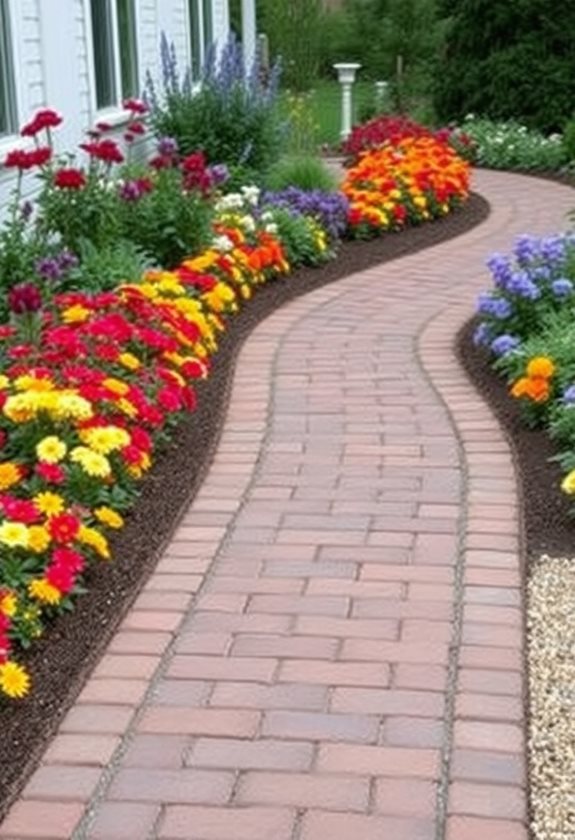
Choosing the right base material for your brick pathways is like picking the perfect shoes for a long hike—it makes all the difference! You want a sturdy foundation, right? Gravel, sand, or crushed stone all work wonders. Here’s a quick breakdown:
Selecting the ideal base for your brick pathways is crucial—think of it as choosing the best shoes for a hike!
- Gravel: Great for drainage and stability.
- Sand: Perfect for leveling and easy adjustments.
- Crushed Stone: Offers excellent support and prevents shifting.
Imagine stepping on a path that feels solid underfoot! Don’t overlook this step; it’s the backbone of your beautiful creation. Additionally, using quality pathway materials will enhance both durability and aesthetics. So, what’s your choice? Let your pathway shine with the right base!
Maintain Your Brick Pathway
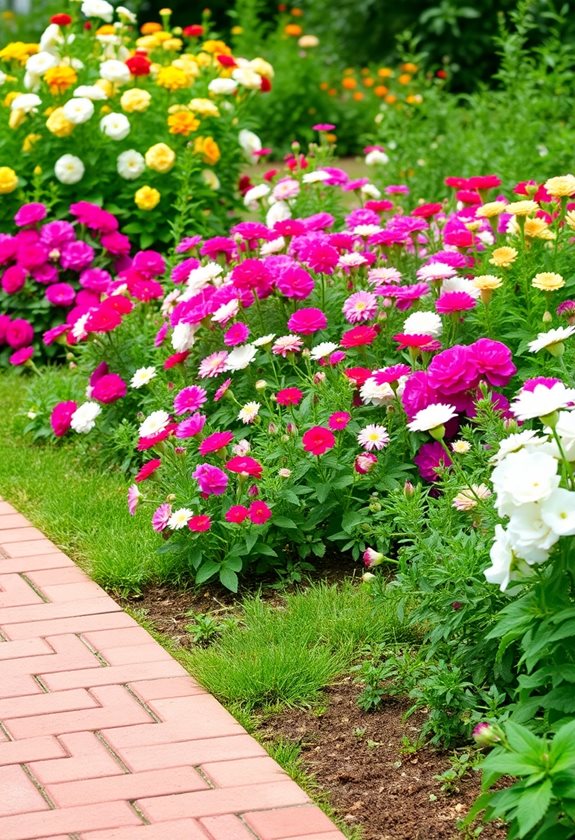
Even though your brick pathway may look stunning now, keeping it in tip-top shape requires a bit of TLC. Regular maintenance not only preserves its beauty but also extends its life. Are you ready to roll up your sleeves? Here are some essential steps:
- Sweep regularly to remove debris and prevent slippery spots.
- Fill gaps between bricks with sand or mortar to avoid weed growth.
- Wash the surface gently with water and mild soap to keep it fresh. Additionally, consider using simple maintenance tips to enhance the longevity of your garden walkways.
Frequently Asked Questions
How Can I Make My Brick Pathway More Slip-Resistant?
Did you know that slips and falls account for over 8 million hospital visits each year? To make your brick pathway slip-resistant, try these steps:
- Add texture: Use sand or gravel between bricks for grip.
- Seal it: A non-slip sealer can work wonders!
- Regular maintenance: Keep leaves and moss off.
With a little effort, you can create a safe and stylish pathway that’s as inviting as your garden!
What Plants Pair Well With Brick Pathways in Flower Gardens?
When you think about plants that complement your brick pathway, consider those that soften the edges while adding color and texture. How about vibrant daylilies or delicate ferns? They thrive in various conditions and create a lush backdrop. If you’re feeling adventurous, try creeping thyme between the bricks for a fragrant touch! Just imagine walking on that! Pairing these plants will not only enhance beauty but also create a welcoming atmosphere in your garden.
Can I Use Recycled Bricks for My Pathway?
Absolutely, you can use recycled bricks for your pathway! Did you know that using reclaimed materials can reduce waste by up to 90%? Not only does this help the environment, but it also adds character to your garden. Just make sure the bricks are clean and structurally sound. You’ll want to create a solid base, lay the bricks tightly, and fill gaps with sand. Isn’t it satisfying to create something beautiful while being eco-friendly?
How Do I Repair Damaged Bricks in My Pathway?
Got some damaged bricks? No worries, you can fix them! First, lift the broken brick and assess the damage. Clean the area, then apply a layer of sand or mortar for a solid base. Place your new or repaired brick back in, giving it a gentle tap to secure it. Finally, fill the gaps with sand, and voila! Your pathway’s looking sharp again! Isn’t it satisfying to restore your hard work?
What Is the Best Time of Year to Install a Brick Pathway?
The best time to install a brick pathway is during spring or early fall. Why? The weather’s mild, making it easier to work without extreme heat or cold. Plus, the ground’s usually more manageable for digging. You’ll want to avoid rainy seasons, or you’ll be wrestling with mud! So, gather your materials, and get ready to create that stunning pathway you’ve been dreaming about—because nothing beats the satisfaction of a job well done!

